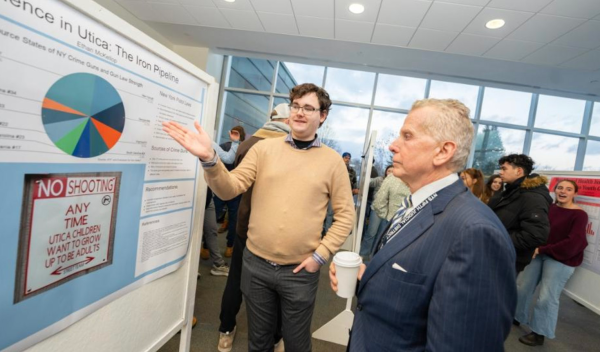
Last week, Hamilton College’s Arthur Levitt Public Affairs Center released a comprehensive report titled “Youth Gun Violence in Utica, New York: Causes, Context, and Prevention.” This report was prepared by students in the Center’s Fall 2024 Justice Lab, a semester-long program for a cohort of 12-16 students involving four integrated courses on complex societal challenges such as criminal justice reform, immigration and asylum and human rights and civil rights.
For the Fall 2024 semester’s Justice Lab, Profs. Frank Anechiarico, Marianne Janack, Jeff McArn and Judge Ralph Eannace (ret) taught four connected courses on the root causes of youth gun violence in the local area, researching best practices for addressing this violence, investigating alternative forms of justice and writing and reflecting on their own experiences of fear and safety. Former Oneida County District Attorney Scott McNamara acted as a Community Partner to the Justice Lab.
The beginning of the report focuses on the social environment, putting the issue of youth gun violence in Utica, New York into local context.
“Economic disparities significantly influence crime rates, particularly in post-industrial cities like Utica. The decline of manufacturing jobs over the last five decades has left many residents struggling to secure stable employment, leading to increased poverty and social dislocation,” the report says. “The resulting concentration of poverty perpetuates crime and limits opportunities for upward mobility (Chetty et al., 2014). Without access to quality education and employment, youth are more likely to engage in behaviors that increase their risk of involvement in gun violence.”
Survey data collected in 2024 by the Hamilton College Levitt Center and Colgate University reveal a strong relationship between economic status and perceptions of safety in Utica. According to the data, individuals earning less than $50,000 annually are more likely to report worsening economic conditions and heightened concerns about crime than those in higher income brackets. Similarly, data suggest that perceptions of safety vary significantly across racial groups. Black and Hispanic residents report greater concern over crime in their neighborhoods compared to white residents.
“Judge Randal Caldwell, who presides over the Teen Accountability Court (TAC), noted that nearly all high-risk youth assessed by the Youth Assessment Screening Instrument (YASI) exhibit histories of childhood trauma, abuse, or neglect. This trauma, left unaddressed, manifests in aggressive behavior, delinquency, and eventual entanglement in violent activities,” the report says.
The report notes that the effectiveness of school resource officers largely depends on the training they receive. While some states mandate specialized training for officers assigned to schools, others provide little to no guidance. According to the report “there is still no statewide requirement for de-escalation training, trauma-informed policing, or crisis intervention techniques related to adolescent mental health.”
Currently, Utica employs school protection officers and school resource officers. According to the students’ research, the school protection officers primarily focus on perimeter checks and surveillance to address external threats. In contrast, school resource officers work within the schools but do not consistently receive specialized training in juvenile policing.
“These officers volunteer for shifts, leading to frequent turnover and a lack of sustained relationships with students and faculty (Finn et al., 2005b, p.7),” the report says.
The report offers a series of recommendations, including reviving gun violence prevention grants, enhancing community policing strategies, establishing a police-community trust initiative, increasing access to Teen Accountability Courts, expanding alternative sentencing programs and establishing permanent School Resource Officers trained in adolescent mental health and conflict resolution.
Utica Mayor Michael P. Galime commented, “The Utica Police Department prides itself on our accreditation standards, training, and use of bleeding edge technology. This is reflected in how our officers interact with and protect our community. As always, the body of work provided by Hamilton College and the Levitt Center for Public Affairs is an example of their work proving its worth in leading our city into the future.”
“With respect to this report, we have added confidence that the direct police work we perform, and the collaborative efforts we undertake to mitigate youth gun violence indirectly through outreach and community involvement are making a difference—with added benefit of reflecting on how we can iteratively improve our efforts in serving the City,” he said in a statement.
The full report is available through Hamilton College’s Arthur Levitt Public Affairs Center and online.
















